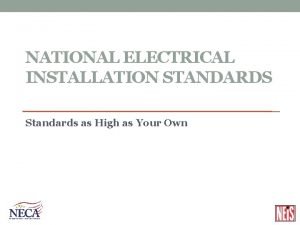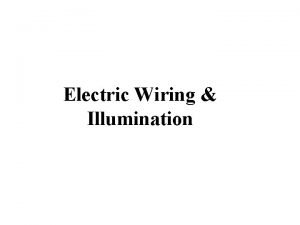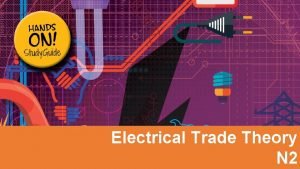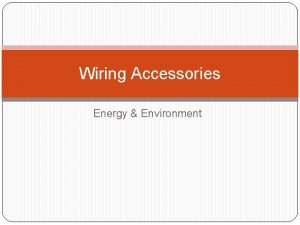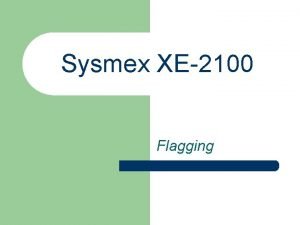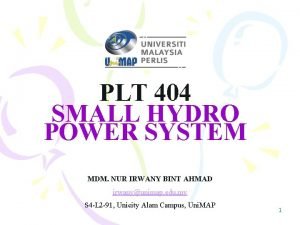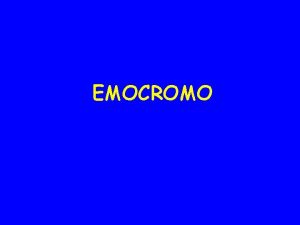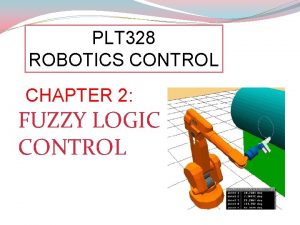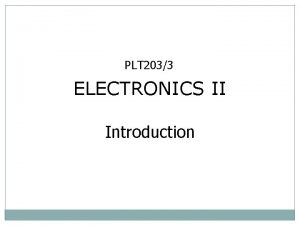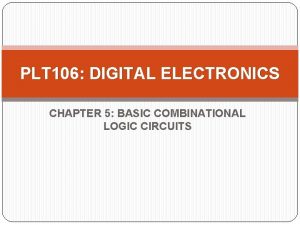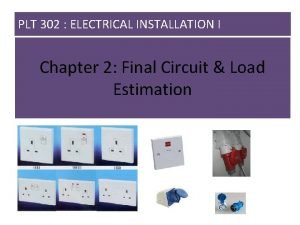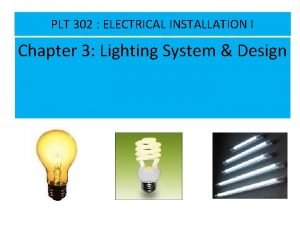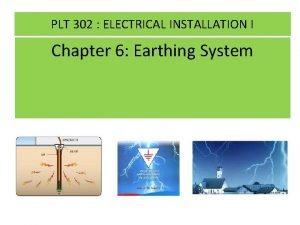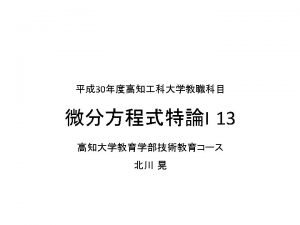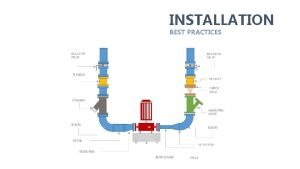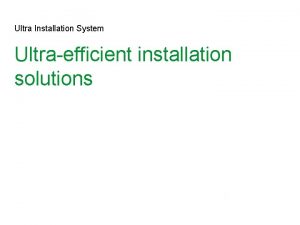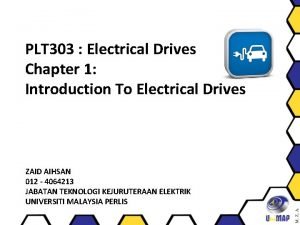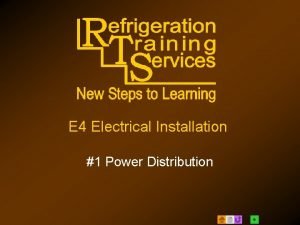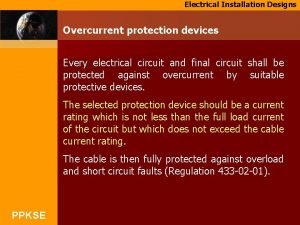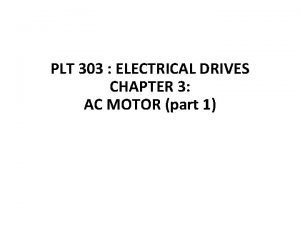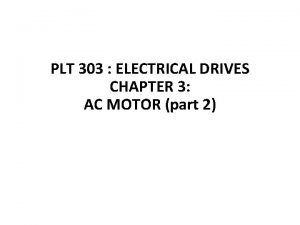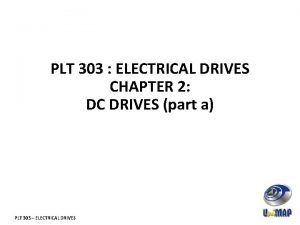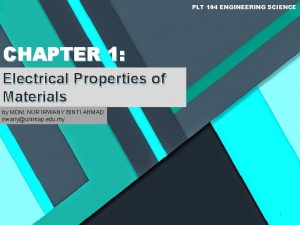PLT 302 ELECTRICAL INSTALLATION I Chapter 1 Introduction


















- Slides: 18

PLT 302 : ELECTRICAL INSTALLATION I Chapter 1: Introduction to Electrical Installation Design

1. 0 Design of Power Distribution System in Buildings The basic principles/factors requiring consideration during design of power distribution system include : ü Function of structure, present and future ü Life and flexibility of structure ü Location of service entrance and distribution equipment, locations and characteristic of loads, locations of unit substations ü Demand diversity factors of loads ü Sources of power, including normal, standby and emergency ü Continuity and quality of power available and required ü Energy efficiency and management ü Distribution and utilization voltages ü Bus and/or cable feeder ü Distribution equipment and motor control ü Types of lighting systems ü Installation methods ü Power monitoring systems ü Electrical utility requirements Faculty of Engineering Technology Sept 2014 Universiti Malaysia Perlis 2

1. 1 Goals of System Design 1. Safety - to design a power system which will not present any electrical hazard to the people who utilize the facility, and/or the utilization equipment fed from the electrical system. 2. Minimum Initial Investment - equipment and installation cost of electrical distribution system is the key factor in determining which various alternate system design are selected. 3. Maximum Flexibility and Expendability - more flexibility for relocated, redesign and expendability for future work Faculty of Engineering Technology Sept 2014 Universiti Malaysia Perlis 3

Con’t 4. Continuity Service - continuity and reliability of power supply needed depending on the use of facility - continuity and reliability service can be increased by i. supply multiple utility power sources ii. supply multiple connection paths to the load iii. using short-time rated power circuit breaker iv. using uninterrupted power supply such as generator or battery v. selecting high quality electrical equipment and conductor vi. systematically of preventive maintenance 5. Maximum Electrical Efficiency - minimize the losses in conductors, transformers and utilizatioin equipment Faculty of Engineering Technology Sept 2014 Universiti Malaysia Perlis 4

Con’t 6. Minimum Maintenance Cost - electricity billing and replacement equipment cost 7. Maximum Power Quality - selected equipment are acceptable operating range, required input voltage, current, power factor, affected by harmonic etc Faculty of Engineering Technology Sept 2014 Universiti Malaysia Perlis 5

1. 2 Low Voltage Distribution System 1. 2. 1 Principles In a typical LV installation, distribution circuits originate at a Main Switch Board (MSB) from which cables are installed in various kinds of cablesways, conduits etc to supply sub switchboard (SSB) and distribution board (DB) Faculty of Engineering Technology Sept 2014 Universiti Malaysia Perlis 6

1. 2 Low Voltage Distribution System MSB (Main Switch Board) -Use in different area of site - Centralised high power load such as air compressor and water cooling SSB (Sub Switch Board) -Use to distribute electricity within each area DB (Distribution Board) -Use to supply the various load Faculty of Engineering Technology Sept 2014 Universiti Malaysia Perlis 7

Basic Topology All distribution system are combination of two basic topologies. • Star topology : Radial or centralised distribution • Bus topology : Distribution using busduct/busway (also referred to busbar trunking system) b) Bus topology a) Star topology Faculty of Engineering Technology Sept 2014 Universiti Malaysia Perlis 8

1. 2 Low Voltage Distribution System 1. 2. 2 Selecting a distribution scheme The LV distribution scheme is selected according to: 1. Energy availability requirements The criterion of independent circuits to different parts of an installation makes it possible to: - Limit the consequences of a fault to the circuit concerned - Simply fault detecting - Carry out maintenance work or circuit extensions without interrupting the supply of power to the whole installation. In general, the following circuit group are required: i. Lighting circuit ii. Socket outlet circuit iii. Heating, ventilation and air conditioning circuit iv. Power circuit for motor driven fixed plant v. Power supply for auxiliary circuit of Engineering Technology vi. Circuit for safety system (UPS, etc) Faculty Universiti Malaysia Perlis Sept 2014 9

Con’t 2. Size of the site Small sites are supplied directly by the utility LV network 3. Load layout Two type of loads depending on their layout on the site must be taken in account; i. Concentrated Load Generally corresponding to building utilities used for entire site and requiring high power e. g centralised air conditioning unit. ii. Distribution Load Can be deal with in group corresponding to a homogeneous area such as floor, factory shop, production line etc 4. Installation flexibility requirement Increasing demand for commercial and industrial premises Faculty of Engineering Technology Sept 2014 Universiti Malaysia Perlis 10

1. 3 Rules and Statutory Regulations LV installations are governed by a number of regulatory and advisory texts such as: • Statutory regulations • Code of practice, regulations issue by professional institutions, job specification • National and international standards for installations • National and international standards for products The electricity supply and installation practice in Malaysia are governed by the following : 1. Electricity Supply Act 1990 – Act 447 and Act 448 2. Licensee Supply Regulation 1990 3. Electricity Regulation 1990 4. OSHA 1994 – Occupational, Safety & Health Act 5. Malaysia Standard MS IEC 60364 Electrical Installation of Buildings 6. IEE Wiring Regulation 17 th Edition Faculty of Engineering Technology Sept 2014 Universiti Malaysia Perlis 11

1. 4 Definition of voltage range LV system refer to distribution voltages below 1000 V. In Malaysia, LV system refers to the three phase four wire system of 400 V between line -to-line and 230 V between line-to-neutral. 3 phase 4 wire or 3 wire systems Nominal Voltage (V) Single phase 3 wire systems Nominal Voltage (V) 50 Hz 60 Hz - 120/208 120/240 - 230/400 277/480 - 400/690 480 - - 347/600 - 1000 600 - Table 1. 1 : Standard voltage between 100 V and 1000 V (IEC 60038) Faculty of Engineering Technology Sept 2014 Universiti Malaysia Perlis 12

Con’t In Malaysia, the design criteria are developed by Tenaga Nasional Berhad (TNB) for steady state supply voltage level fluctuation of the low voltage system can be divided into: 1. Steady state voltage level fluctuation under normal condition: 400 V/230 V ± 10% to +5% 2. Steady state voltage level fluactuation under contigency condition : 400 V/230 V ± 10% Faculty of Engineering Technology Sept 2014 Universiti Malaysia Perlis 13

1. 5 TNB Supply Schemes and Maximum Demand Level for LV System Table 1. 2 shows the typical supply schemes for maximum demand (MD) level for individual customer for low voltage system provided by TNB. MD Range of individual customer Supply Voltage Typical Supply Schme Up to 12 k. VA 230 V Overhead services from LV mains 12 k. VA to 100 k. VA 400 V 3 phase overhead or underground cable service from existing LV mains 100 k. VA to 1000 k. VA 400 V Direct cable services from LV board from a substation Table 1. 2 : Typical supply schemes for various Maximum Demand (MD) levels Faculty of Engineering Technology Sept 2014 Universiti Malaysia Perlis 14

1. 5 TNB Supply Schemes and Maximum Demand Level for LV System Table 1. 3 and 1. 4 indicates the typical ranges of maximum demand for domestic and shop houses respectively. No Type of Premises Minimum (k. W) Average (k. W) Maximum (k. W) 1 Low cost flats, single storey terrace 1. 5 2. 0 3. 0 2 Double storey terrace or apartment 3. 0 4. 0 5. 0 3 Single storey, semidetached 3. 0 5. 0 7. 0 4 Single storey bungalow & three room condominium 5. 0 7. 0 10. 0 5 Double storey bungalow & luxury 8. 0 12. 0 15. 0 Table 1. 2 : Typical supply schemes for various Maximum Demand (MD) levels condominium Table 1. 3 : Range of Maximum Demand (MD) for domestic customer subclasses or premises Faculty of Engineering Technology Sept 2014 Universiti Malaysia Perlis 15

Con’t Table 1. 3 and 1. 4 indicates the typical ranges of maximum demand for domestic and shop houses respectively. No Type of Premises Minimum (k. W) Average (k. W) Maximum (k. W) 1 Single storey, semidetached 5 10 15 2 Double storey shop house 15 20 25 3 Three storey shop house 20 30 35 4 Four storey shop house 25 35 45 5 Five storey shop house 30 40 55 Table 1. 4 : Range of Maximum Demand (MD) for types of shophouses Faculty of Engineering Technology Sept 2014 Universiti Malaysia Perlis 16

1. 6 Types of Supply Application For LV Supply application, these requirement need to be consider: i. Single phase, 230 V up to 12 k. VA maximum demand ii. 3 phase, 400 V up to 45 k. VA maximum demand iii. 3 phase, current transformer(CT) metered 40 V, up to 1000 k. V maximum demand Types of supply application are provided by TNB can be classified into three types: 1. Supply application for load up to 100 k. VA • Supply usually from existing supply mains • Submission of application to TNBD by Electrical Contractor registered with Suruhanjaya Tenaga (ST) • Processing period for supply will take a maximum of 3 weeks upon approval from the local authorities. Faculty of Engineering Technology Sept 2014 Universiti Malaysia Perlis 17

1. 6 Types of Supply Application 2. Supply application for load exceeding 100 k. VA • Supply may require establishment of new substation • Submission of applications to TNBD by Consultant Engineer • Processing period for supply may take between 6 moths to 3 years depending on the extent of electrical infrastructure required 3. Supply application for streetlight • Application made by local authority • Application by developer • Application by individual Faculty of Engineering Technology Sept 2014 Universiti Malaysia Perlis 18
 Ansi/neca 1-2015
Ansi/neca 1-2015 Electrical installation accessories
Electrical installation accessories What is estimation in electrical engineering
What is estimation in electrical engineering Electrical trade theory n2 conductors and cables
Electrical trade theory n2 conductors and cables 3 pin plug wiring
3 pin plug wiring Wbc ip message blasts/abn lympho
Wbc ip message blasts/abn lympho Plt-o sysmex
Plt-o sysmex Mdm hydra
Mdm hydra Principio impedenziometrico
Principio impedenziometrico Plt scheme
Plt scheme Fuzzification
Fuzzification Plt electronics
Plt electronics Plt 106
Plt 106 Introduction to high voltage technology
Introduction to high voltage technology Fcps my plt
Fcps my plt Cbc with plt
Cbc with plt Plt uts
Plt uts คืออะไร
คืออะไร Plt morphology
Plt morphology
